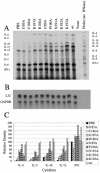Modulation of protective immunity, eosinophilia, and cytokine responses by selective mutagenesis of a recombinant G protein vaccine against respiratory syncytial virus
- PMID: 15767454
- PMCID: PMC1061523
- DOI: 10.1128/JVI.79.7.4527-4532.2005
Modulation of protective immunity, eosinophilia, and cytokine responses by selective mutagenesis of a recombinant G protein vaccine against respiratory syncytial virus
Abstract
Using an Escherichia coli-grown plasmid vector encoding a fragment of thioredoxin (Trx) fused to a central region (amino acids 128 to 229) of the respiratory syncytial virus (RSV) (Long strain) G protein, we employed site-directed mutagenesis to investigate the importance of selected amino acids to vaccine efficacy. Mice were immunized with a total of 10 wild-type or mutant Trx-G proteins and challenged intranasally with RSV. Striking differences in the induction of RSV G-protein-specific antibodies, protection against RSV challenge, cytokine RNA responses, and induction of RSV-associated eosinophilic inflammation were observed among the mutant proteins examined. Taken together, the results identify a critical role for specific amino acids in the induction of protective immunity and priming for eosinophilia against RSV.
Figures




Similar articles
-
A single amino acid substitution in a recombinant G protein vaccine drastically curtails protective immunity against respiratory syncytial virus (RSV).Vaccine. 2003 Jun 2;21(19-20):2500-5. doi: 10.1016/s0264-410x(03)00044-6. Vaccine. 2003. PMID: 12744884
-
Murine host responses to respiratory syncytial virus (RSV) following intranasal administration of a Protollin-adjuvanted, epitope-enhanced recombinant G protein vaccine.J Clin Virol. 2009 Apr;44(4):287-91. doi: 10.1016/j.jcv.2009.01.009. Epub 2009 Feb 23. J Clin Virol. 2009. PMID: 19233722
-
Liposome encapsulation of a soluble recombinant fragment of the respiratory syncytial virus (RSV) G protein enhances immune protection and reduces lung eosinophilia associated with virus challenge.Vaccine. 2000 Jan 6;18(11-12):1110-7. doi: 10.1016/s0264-410x(99)00373-4. Vaccine. 2000. PMID: 10590333
-
Alphavirus replicon particles encoding the fusion or attachment glycoproteins of respiratory syncytial virus elicit protective immune responses in BALB/c mice and functional serum antibodies in rhesus macaques.Vaccine. 2007 Oct 10;25(41):7132-44. doi: 10.1016/j.vaccine.2007.07.065. Epub 2007 Aug 21. Vaccine. 2007. PMID: 17850933
-
Understanding respiratory syncytial virus (RSV) vaccine-enhanced disease.Immunol Res. 2007;39(1-3):225-39. doi: 10.1007/s12026-007-0071-6. Immunol Res. 2007. PMID: 17917067 Review.
Cited by
-
Prophylactic treatment with a G glycoprotein monoclonal antibody reduces pulmonary inflammation in respiratory syncytial virus (RSV)-challenged naive and formalin-inactivated RSV-immunized BALB/c mice.J Virol. 2010 Sep;84(18):9632-6. doi: 10.1128/JVI.00451-10. Epub 2010 Jun 30. J Virol. 2010. PMID: 20592094 Free PMC article.
-
Effects of alveolar macrophage depletion on liposomal vaccine protection against respiratory syncytial virus (RSV).Clin Exp Immunol. 2006 Jul;145(1):147-54. doi: 10.1111/j.1365-2249.2006.03114.x. Clin Exp Immunol. 2006. PMID: 16792685 Free PMC article.
-
Respiratory syncytial virus (RSV) evades the human adaptive immune system by skewing the Th1/Th2 cytokine balance toward increased levels of Th2 cytokines and IgE, markers of allergy--a review.Virus Genes. 2006 Oct;33(2):235-52. doi: 10.1007/s11262-006-0064-x. Virus Genes. 2006. PMID: 16972040 Review.
-
TLR7 promotes chronic airway disease in RSV-infected mice.Front Immunol. 2023 Sep 14;14:1240552. doi: 10.3389/fimmu.2023.1240552. eCollection 2023. Front Immunol. 2023. PMID: 37795093 Free PMC article.
References
-
- Chin, J., R. L. Magoffin, L. A. Shearer, J. H. Schieble, and E. H. Lennette. 1969. Field evaluation of a respiratory syncytial virus vaccine and a trivalent parainfluenza virus vaccine in a pediatric population. Am. J. Epidemiol. 89:449-463. - PubMed
-
- Connors, M., N. A. Giese, A. B. Kulkarni, C. Y. Firestone, H. C. Morse, and B. R. Murphy. 1994. Enhanced pulmonary histopathology induced by respiratory syncytial virus (RSV) challenge of formalin-inactivated RSV-immunized BALB/c mice is abrogated by depletion of interleukin-4 (IL-4) and IL-10. J. Virol. 68:5321-5325. - PMC - PubMed
-
- de Waal, L., S. Yuksel, A. H. Brandenburg, J. P. M. Langedijk, K. Sintnicolaas, G. M. G. M. Verjans, A. D. M. E. Osterhaus, and R. L. de Swart. 2004. Identification of a common HLA-DP4-restricted T-cell epitope in the conserved region of the respiratory syncytial virus G protein. J. Virol. 78:1775-1781. - PMC - PubMed
-
- Doherty, P. C. 1994. Vaccines and cytokine-mediated pathology in RSV infection. Trends Microbiol. 2:148-149. - PubMed
Publication types
MeSH terms
Substances
LinkOut - more resources
Full Text Sources
Other Literature Sources
Medical

